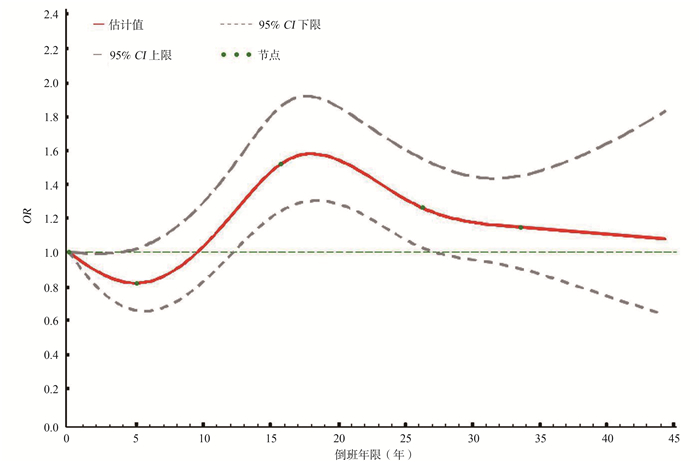Effects of rotating night shift work and sleep duration on liver dysfunction among steelworkers
-
摘要:
目的 探讨倒班、平均睡眠时间及其联合作用对钢铁工人肝功能异常的影响,为保护钢铁工人肝脏提供理论依据。 方法 采用横断面研究,以某钢铁公司6 907名工人作为研究对象, 并收集信息。采用非条件Logistic回归分析模型和限制性立方样条函数进行分析。 结果 肝功能异常的检出率为18.0%,且男性高于女性(19.2% vs. 5.1%)。调整混杂因素后,倒班年限和肝功能异常之间存在非线性剂量反应关系。倒班和平均倒班频率>7夜/月患肝功能异常的风险分别增加1.24倍(OR=1.24, 95% CI: 1.04~1.49)和1.29倍(OR=1.29, 95% CI: 1.07~1.56)。以倒班状态分层,在倒班工人中平均睡眠时间较短(≤5 h/d)和较长(>7 h/d)患肝功能异常的风险分别增加1.19倍(OR=1.19, 95% CI: 1.01~1.43)和1.22倍(OR=1.22, 95% CI: 1.02~1.44)。且平均睡眠时间较长或较短均与倒班存在正向相乘的交互作用。根据平均睡眠时间分层后,平均睡眠时间>5~7 h/d的各倒班指标与肝功能异常的联系无统计学意义。 结论 倒班工作和睡眠时间较长或较短联合作用会增加钢铁工人肝功能异常的风险,倒班工作对肝功能异常的独立作用也不容忽视。 Abstract:Objective To investigate the effects of rotating night shift work and average sleep duration and their combined effects on liver dysfunction of steelworkers, and to provide theoretical basis for liver protection of steelworkers. Methods In this cross-sectional study, a total of 6 907 workers from a steel company were recruited, and their indicators were collected. These indicators were analyzed by the unconditional Logistic regression model and the restricted cubic spline function. Results The detection rate of liver dysfunction was 18.0%, which was significantly higher in males than in females (19.2% vs. 5.1%). After adjusting for the confounding factors, there was a non-linear dose-response relationship between duration of night shifts and liver dysfunction, and the odds of liver dysfunction in night shift workers and average frequency of night shifts > 7 nights/month were increased by 1.24 (OR=1.24, 95% CI: 1.04-1.49) and 1.29 (OR=1.29, 95% CI: 1.07-1.56), respectively. When stratified by current shift status, compared with the average sleep duration of > 5-7 h/d, the odds of liver dysfunction in shorter sleep duration (≤5 h/d) and longer sleep duration (> 7 h/d) were increased by 1.19 (OR=1.19, 95% CI: 1.01-1.43) and 1.22 (OR=1.22, 95% CI: 1.02-1.44) among night shift workers. And there was a positive interaction between longer or shorter average sleep duration and current shift status. After stratified by average sleep duration, only in the layer with an average sleep duration of > 5-7 h/d, there was no statistically significant relationship between different exposure metrics of night shift work and liver function. Conclusion The combined effects of rotating night shift work and longer or shorter sleep duration increases the risk of liver dysfunction, and the independent effects of rotating night shift work cannot be ignored. -
Key words:
- Rotating night shift work /
- Sleep duration /
- Liver dysfunction /
- Cross-sectional study
-
表 1 研究对象的基本特征分析[n(%)]
Table 1. Basic characteristic of the study subjects [n(%)]
变量 总人口(N=6 907) 肝功能异常 P值 否(n=5 664) 是(n=1 243) 性别 < 0.001 女 590(8.5) 560(9.9) 30(2.4) 男 6 317(91.5) 5 104(90.1) 1 213(97.6) 吸烟 < 0.001 从不 3 029(43.9) 2 606(46.0) 423(34.0) 曾经 365(5.2) 296(5.2) 69(5.6) 现在 3 513(50.9) 2 762(48.8) 751(60.4) 饮酒 < 0.001 从不 4 225(61.2) 3 628(64.0) 597(48.0) 曾经 147(2.1) 121(2.2) 26(2.1) 现在 2 535(36.7) 1 915(33.8) 620(49.9) 体力活动水平 0.689 低 127(1.8) 105(1.9) 22(1.8) 中 683(9.9) 568(10.0) 115(9.2) 高 6 097(88.3) 4 991(88.1) 1 106(89.0) 平均睡眠时间(h/d) 0.194 ≤5 1 186(17.2) 957(16.9) 229(18.4) >5~7 4 155(60.1) 3 435(60.6) 720(57.9) >7 1 566(22.7) 1 272(22.5) 294(23.7) 糖尿病 0.726 否 6 171(89.3) 5 057(89.3) 1 114(89.6) 是 736(10.7) 607(10.7) 129(10.4) 高血压 0.799 否 5 031(72.8) 4 122(72.8) 909(73.1) 是 1 876(27.2) 1 542(27.2) 334(26.9) 血脂异常 0.387 否 4 187(60.6) 3 420(60.4) 767(61.7) 是 2 720(39.4) 2 244(39.6) 476(38.3) 肾功能损伤 0.516 否 5 826(84.3) 4 770(84.2) 1056(85.0) 是 1 081(15.7) 894(15.8) 187(15.0) BMI (kg/m2) 0.050 < 24 2 329(33.7) 1 926(34.0) 403(32.4) 24~ < 28 3 435(49.7) 2 780(49.1) 655(52.7) ≥28 1 143(16.6) 958(16.9) 185(14.9) 高温 < 0.001 否 3 408(49.3) 2 851(50.3) 557(44.8) 是 3 499(50.7) 2 813(49.7) 686(55.2) 噪声 0.362 否 53(0.8) 46(0.8) 7(0.6) 是 6 854(99.2) 5 618(99.2) 1 236(99.4) 粉尘 0.251 否 2 398(34.7) 1 949(34.4) 449(36.1) 是 4 509(65.3) 3 715(65.6) 794(63.9) CO 0.780 否 3 831(55.5) 3 146(55.5) 685(55.1) 是 3 076(44.5) 2 518(44.5) 558(44.9) 年龄(x±s, 岁) 43.16±8.51 43.15±8.62 43.25±8.00 0.880 DASH评分(x±s, 分) 21.64±2.21 21.71±2.20 21.29±2.21 < 0.001 倒班状态 0.004 从不 1 136(16.4) 966(17.1) 170(13.7) 倒班 5 771(83.6) 4 698(82.9) 1 073(86.3) 倒班年限(年) 0.006 从不 1 136(16.4) 966(17.1) 170(13.7) ≤19 2 805(40.7) 2 302(40.6) 503(40.5) >19 2 966(42.9) 2 396(42.3) 570(45.8) 平均倒班频率(夜/月) 0.003 从不 1 136(16.4) 966(17.1) 170(13.7) ≤7 2 097(30.4) 1 733(30.6) 364(29.3) >7 3 674(53.2) 2 965(52.3) 709(57.0) 注: 倒班年限、平均倒班频率的截断点分别是各自变量的中位数。 表 2 各倒班指标与平均睡眠时间对肝功能异常的影响
Table 2. The effect of different exposure metrics of night shift work and average sleep duration on liver dysfunction
变量 人数(N) OR(95% CI)值 模型1 模型2 模型3 倒班状态 从不倒班 1 136 1.00 1.00 1.00 倒班 5 771 1.30(1.09~1.55) 1.27(1.06~1.52) 1.24(1.04~1.49) 平均倒班频率(夜/月) 从不倒班 1 136 1.00 1.00 1.00 ≤7 2 097 1.19(0.98~1.46) 1.18(0.97~1.44) 1.17(0.95~1.43) >7 3 674 1.36(1.13~1.63) 1.32(1.10~1.58) 1.29(1.07~1.56) 平均睡眠时间(h/d) ≤5 1 186 1.13(0.95~1.33) 1.13(0.96~1.34) 1.11(0.93~1.31) >5~7 4 155 1.00 1.00 1.00 >7 1 566 1.12(0.99~1.30) 1.14(0.98~1.33) 1.16(0.99~1.35) 注: 模型1:没有调整混杂因素;模型2:调整了性别、年龄;模型3:调整了性别、年龄、饮酒、吸烟、体力活动水平、DASH评分、BMI、血脂异常、高血压、糖尿病、肾功能损伤、以及职业有害因素(高温、噪声、粉尘和CO)的接触情况;倒班年限、平均倒班频率的截断点分别是各自变量的中位数。 表 3 倒班状态与平均睡眠时间对肝功能异常的联合作用
Table 3. Combined effects of current shift status and average sleep duration on liver dysfunction
变量 人数(N) OR(95% CI)值 模型1 模型2 模型3 倒班状态 平均睡眠时间(h/d) 从不倒班 ≤5 122 0.64(0.35~1.16) 0.63(0.35~1.15) 0.61(0.33~1.12) >5~7 660 1.00 1.00 1.00 >7 354 0.72(0.50~1.05) 0.76(0.52~1.10) 0.75(0.51~1.10) 倒班 ≤5 1 064 1.20(1.01~1.43) 1.22(1.02~1.45) 1.19(1.01~1.43) >5~7 3 495 1.00 1.00 1.00 >7 1 212 1.22(1.01~1.43) 1.23(1.01~1.42) 1.22(1.02~1.44) 交互作用1 1.87(1.01~3.47) 1.89(1.02~3.51) 1.92(1.03~3.60) 交互作用2 1.11(1.01~1.22) 1.09(1.02~1.21) 1.10(1.01~1.21) 平均睡眠时间(h/d) 倒班年限(年) ≤5 从不倒班 122 1.00 1.00 1.00 ≤19 397 1.92(1.04~3.52) 1.66(0.89~3.10) 1.74(0.92~3.30) >19 667 1.98(1.10~3.56) 2.09(1.15~3.80) 2.07(1.13~3.81) >5~7 从不倒班 660 1.00 1.00 1.00 ≤19 1 707 1.05(0.82~1.33) 1.00(0.78~1.29) 1.02(0.79~1.31) >19 1 788 1.04(0.82~1.32) 1.04(0.82~1.33) 1.00(0.78~1.29) >7 从不倒班 354 1.00 1.00 1.00 ≤19 701 1.51(1.04~2.17) 1.54(1.06~2.24) 1.48(1.01~2.17) >19 511 2.18(1.50~3.16) 1.86(1.26~2.74) 1.69(1.13~2.53) 平均睡眠时间(h/d) 平均倒班频率(夜/月) ≤5 从不倒班 122 1.00 1.00 1.00 ≤7 353 1.68(0.90~3.12) 1.71(0.92~3.20) 1.78(0.94~3.37) >7 711 2.09(1.17~3.77) 2.02(1.12~3.63) 2.02(1.11~3.68) >5~7 从不倒班 660 1.00 1.00 1.00 ≤7 1 245 0.96(0.75~1.24) 0.96(0.74~1.24) 0.95(0.73~1.23) >7 2 250 1.09(0.87~1.37) 1.06(0.84~1.34) 1.05(0.82~1.33) >7 从不倒班 354 1.00 1.00 1.00 ≤7 499 1.68(1.14~2.46) 1.57(1.07~2.32) 1.53(1.03~2.28) >7 713 1.85(1.29~2.65) 1.76(1.22~2.53) 1.59(1.09~2.32) 注: 模型1:没有调整混杂因素;模型2:调整了性别、年龄;模型3:调整了性别、年龄、饮酒、吸烟、体力活动水平、DASH评分、BMI、血脂异常、高血压、糖尿病、肾功能损伤、以及职业有害因素(高温、噪声、粉尘和CO)的接触情况;交互作用1:倒班状态和平均睡眠时间(≤5 h/d与>5~7 h/d相比);交互作用2:倒班状态和平均睡眠时间(>7 h/d与>5~7 h/d相比)。 -
[1] Knutsson A. Methodological aspects of shift-work research[J]. Chronobiol Int, 2004, 21(6): 1037-1047. DOI: 10.1081/cbi-200038525. [2] Lu K, Chen J, Wang L, et al. Association of sleep duration, sleep quality and shift-work schedule in relation to hypertension prevalence in Chinese adult males: a cross-sectional survey[J]. Int J Environ Res Public Health, 2017, 14(2): 210. DOI: 10.3390/ijerph14020210. [3] Fedeli U, Avossa F, Guzzinati S, et al. Trends in mortality from chronic liver disease[J]. Ann Epidemiol, 2014, 24(7): 522-526. DOI: 10.1016/j.annepidem.2014.05.004. [4] Yang L, Zhou M, Sherliker P, et al. Alcohol drinking and overall and cause-specific mortality in China: nationally representative prospective study of 220, 000 men with 15 years of follow-up[J]. Int J Epidemiol, 2012, 41(4): 1101-1113. DOI: 10.1093/ije/dys075. [5] Asher G, Schibler U. Crosstalk between components of circadian and metabolic cycles in mammals[J]. Cell Metab, 2011, 13(2): 125-137. DOI: 10.1016/j.cmet.2011.01.006. [6] Eckel-Mahan K, Sassone-Corsi P. Metabolism and the circadian clock converge[J]. Physiol Rev, 2013, 93(1): 107-135. DOI: 10.1152/physrev.00016.2012. [7] Mukherji A, Bailey SM, Staels B, et al. The circadian clock and liver function in health and disease[J]. J Hepatol, 2019, 71(1): 200-211. DOI: 10.1016/j.jhep.2019.03.020. [8] Itani O, Jike M, Watanabe N, et al. Short sleep duration and health outcomes: a systematic review, meta-analysis and meta-regression[J]. Sleep Med, 2017, 32: 246-256. DOI: 10.1016/j.sleep.2016.08.006. [9] Tan X, Chapman CD, Cedernaes J, et al. Association between long sleep duration and increased risk of obesity and type 2 diabetes: a review of possible mechanisms[J]. Sleep Med Rev, 2018, 40: 127-134. DOI: 10.1016/j.smrv.2017.11.001. [10] Imaizumi H, Takahashi A, Tanji N, et al. The association between sleep duration and non-alcoholic fatty liver disease among Japanese men and women[J]. Obes Facts, 2015, 8(4): 234-242. DOI: 10.1159/000436997. [11] Liu C, Zhong R, Lou J, et al. Nighttime sleep duration and risk of nonalcoholic fatty liver disease: the Dongfeng-Tongji prospective study[J]. Ann Med, 2016, 48(6): 468-476. DOI: 10.1080/07853890.2016.1193787. [12] Farrell GC, Chitturi S, Lau GK, et al. Guidelines for the assessment and management of non-alcoholic fatty liver disease in the Asia-Pacific region: executive summary[J]. J Gastroenterol Hepatol, 2007, 22(6): 775-777. DOI: 10.1111/j.1440-1746.2007.05002.x. [13] 张生奎, 王镇德, 杨荔, 等. 倒班作业与高尿酸血症的剂量反应关系研究[J]. 中华疾病控制杂志, 2018, 22(11): 1123-1127. DOI: 10.16462/j.cnki.zhjbkz.2018.11.008.Zhang SK, Wang ZD, Yang L, et al. Dose-response relationship between shift work and hyperuricemia[J]. Chin J Dis Prev, 2018, 22(11): 1123-1127. DOI: 10.16462/j.cnki.zhjbkz.2018.11.008. [14] Lin YC, Chen PC. Persistent rotating shift work exposure is a tough second hit contributing to abnormal liver function among on-site workers having sonographic fatty liver[J]. Asia Pac J Public Health, 2015, 27(2): NP1765-NP1774. DOI: 10.1177/1010539512469248. [15] Nakamura K, Motohashi Y, Kikuchi S, et al. Liver transferase activity in healthy Japanese employees aged 18-39 years[J]. Ind Heal, 1998, 36(3): 218-222. DOI: 10.2486/indhealth.36.218. [16] Mikolasevic I, Domislovic V, Filipec Kanizaj T, et al. Relationship between coffee consumption, sleep duration and smoking status with elastographic parameters of liver steatosis and fibrosis; controlled attenuation parameter and liver stiffness measurements[J]. Int J Clin Pract, 2020, 18: e13770. DOI: 10.1111/ijcp.13770. [17] Lie JA, Kjuus H, Zienolddiny S, et al. Night work and breast cancer risk among Norwegian nurses: assessment by different exposure metrics[J]. Am J Epidemiol, 2011, 173(11): 1272-1279. DOI: 10.1093/aje/kwr014. [18] Zhang S, Wang Y, Wang Z, et al. Rotating night shift work and non-alcoholic fatty liver disease among steelworkers in China: a cross-sectional survey[J]. Occup Environ Med, 2020, 77(5): 333-339. DOI: 10.1136/oemed-2019-106220. [19] Carrillo-Iregui A, Lopez-Mitnik G, Cossio S, et al. Relationship between aminotransferases levels and components of the metabolic syndrome among multiethnic adolescents[J]. J Pediatr Endocrinol Metab, 2010, 23(12): 1253-1261. DOI: 10.1515/jpem.2010.199. [20] Alam S, Noor-E-Alam SM, Chowdhury ZR, et al. Nonalcoholic steatohepatitis in nonalcoholic fatty liver disease patients of Bangladesh[J]. World J Hepatol, 2013, 5(5): 281-287. DOI: 10.4254/wjh.v5.i5.281. [21] Lin YC, Hsiao TJ, Chen PC. Shift work aggravates metabolic syndrome development among early-middle-aged males with elevated ALT[J]. World J Gastroenterol, 2009, 15(45): 5654-5661. DOI: 10.3748/wjg.15.5654. [22] Zhou H, Du W, Li Y, et al. Effects of melatonin on fatty liver disease: the role of NR4A1/DNA-PKcs/p53 pathway, mitochondrial fission, and mitophagy[J]. J Pineal Res, 2018, 64(1). DOI: 10.1111/jpi.12450. [23] Rivera-Coll A, Fuentes-Arderiu X, Díez-Noguera A. Circadian rhythms of serum concentrations of 12 enzymes of clinical interest[J]. Chronobiol Int, 1993, 10(3): 190-200. DOI: 10.3109/07420529309073887. [24] Wu AH, Stanczyk FZ, Wang RW, et al. Sleep duration, spot urinary 6-sulfatoxymelatonin levels and risk of breast cancer among Chinese women in Singapore[J]. Int J Cancer, 2013, 132(4): 891-896. DOI: 10.1002/ijc.27653. [25] Wang XS, Armstrong ME, Cairns BJ, et al. Shift work and chronic disease: the epidemiological evidence[J]. Occup Med (Lond), 2011, 61(2): 78-89. DOI: 10.1093/occmed/kqr001. [26] Wang P, Ren FM, Lin Y, et al. Night-shift work, sleep duration, daytime napping, and breast cancer risk[J]. Sleep Med, 2015, 16(4): 462-468. DOI: 10.1016/j.sleep.2014.11.017. -





 下载:
下载:

